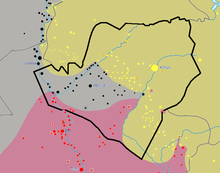Kirkuk Governorate
35.344Coordinates: 35° 18′ N, 44° 0′ E
Kirkuk (Arabic كركوك, DMG Kirkuk, Kurdish کەرکووک Kerkûk, Aramaic ܟܪܟ ܣܠܘܟ, from 1976 to 2006 at-Taʾmīm / التأميم / 'nationalization') is an Iraqi governorate with an area of 10.282 km² and a population of 1.5 million (2008). Kurds now make up the majority of the population. Since the 2003 Iraq War, about 100,000 Arabs have left the governorate, while about 300,000 Kurdish refugees have returned. The Kurds speak Sorani. In addition, there are still Arabs, Turkmen and Arameans. The capital of the governorate is the eponymous city of Kirkuk. After the US invasion in 2003, part of the governorate is under the control of the Autonomous Region of Kurdistan. Since July 2014, the governorate has been mostly under Kurdish control after Iraqi forces withdrew. The south around Hawijah was under IS control until September 2017. Several battles took place just south of the town. In September 2017, Hawijah and the surrounding area were captured by Iraqi forces. Starting in October 2017, Iraqi forces began an assault on Kirkuk and the surrounding area. On October 16, 2017, the Kurds withdrew largely without a fight.
The districts of the governorate are:

The province was divided into three parts from 2014 to October 2017: Yellow = Kurds, Grey = IS, Red = Central Government, after October 2017 IS was driven out of this region
Reorganization of the governance boundaries
In the course of the Arabization policy of the Baathre regime, the governorate lost a considerable part of its area. Thus, some districts were assigned to other provinces. Tuz Churmatu was added to Salah ad-Din and Jamjamāl to as-Sulaimaniyya. The name of the governorate was changed in 1972 to at-Taʿmīm ("the nationalization") to symbolize the nationalization of the oil industry, centered in Kirkuk. As part of the reversal of the Arabization policy, the province is to regain formerly associated districts. The affected districts would be Kifri, Jamjamāl, Tuz Khurmatu, and Kalar. The goal of the reorganization of the governorate borders is to influence the ethnic population ratios, i.e. to achieve a non-Kurdish or Kurdish majority in the governorate.
In 2006, the former name Kirkuk was reinstated.
Trivia
- On October 15, 2005, according to official figures, 62.91 percent of 542,688 voters voted yes to the new Iraqi constitution, but Sunni Arabs had largely boycotted the vote.
- Since December 2008, Turkmen and Syriac-Aramaic have also been official languages of the governorate, in addition to Arabic and Kurdish.
Search within the encyclopedia